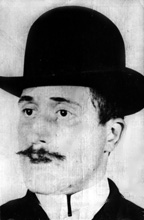Prominent Poles
Guillaume Apollinaire (Wilhelm Apolinaris Kostrowicki aka Guillaume Apollinaris de Kostrowitzky) - French poet, writer, playwright

Born: August 26, 1880, Rome, Italy
Died: November 9, 1918, Paris, France
Summary. Apollinaire was a poet who took part in all avant-garde movements in French literature at the beginning of the 20th century. Besides writing poetry, he published semi-pornographical books; he was an innovator in the theatre of the absurd, and made known Cubism as a school of painting with his study, "Les Peintres cubistes" ("The Cubist Painters") in 1913. During the World War I, Apollinaire enlisted and fought on the front. In a letter, he described war as a "beautiful thing" and continued: "... despite all the risks I run, the exhaustion, the total lack of water, of everything, I am not unhappy to be here..."
Early days. Apollinaire';s mother was a Polish countess, Angelica (Angelique?) Kostrowicki. His father was possibly, Francesco Flugi d'Aspermont, a Swiss-Italian aristocrat who disappeared early from Apollinaire's life. The future poet was raised by his gambling mother in Italy, in Monaco, on the French Riviera, and in Paris. In his youth, Apollinaire assumed the identity of a Russian prince. He received a French education at the Collčge Saint-Charles in Monaco, and afterwards in schools in Cannes and in 1896 in Nice.
Settles in Paris. In 1900, Apollinaire settled in Paris where he worked for a time in a bank. He contibuted to such periodicals as: La Revue blanche, La Plume, and Le Mercure de France. In 1903, he founded his own magazine, Le Festin d'Esope, and the short-lived La Revue immoraliste. Among his friends were such artists as Pablo Picasso, André Derain, playwright Alfred Jarry, and the painter Marie Laurencin, who was his lover.
Tutoring in Germany. Meeting Picasso and Braque. At the age of twenty-one, Apollinaire traveled in Germany. In 1901-02, he worked as a tutor in the Rhineland. Although Apollinaire wrote poetry, he was more known in the following years as the advocate of modern painting. He brought Picasso and Braque together, and helped organize the cubist room 41 at the Salon des Indépendants in 1911. Apollinaire also edited a number of reviews, published satirical and semi-pornographical texts, and proclaimed that the writing of de Sade would dominate the 20th-century.
Recognition. Apollinaire's first collection of poems, L'enchanteur pourrissant (The Rotting Magicians), appeared in 1909, but it was in 1913 with the publication of Alcools (Alcohols) when he was recognized as a highly original voice in contemporary poetry. The Rotting Magicians was illustrated with woodcuts by Derain. The prose-poem depicted the entombment of Merlin the Enchanter by his love. From his sufferings, Merlin creates a new world of poetry. Le Bestiaire ou Cortège d'Orphée (Bestiary-1911), published with woodcuts by Raoul Dufy, was later set to music by Francis Poulenc. Alcohols was a selection of poems written over the previous 15 years. When cubism had become a powerful force, Apollinaire published "The Cubist Painters" which explored the theory of cubism and psychologically analyzed the chief cubists and their works. Ten days after the appearance of the book, Apollinaire deserted cubism for orphism. The concept was also invented by him and described "the art of painting new structures out of elements that have not been borrowed from the visual sphere but have been created entirely by the artist himself, and have been endowed by him with the fullness of reality." Among orphicist artists were Robert Delaunay, Fernand Léger, Francis Picabia, and Frantisek Kupka. In 1914, Apollinaire had a short-lived affair with Louise de Coligny, then with a schoolteacher called Madeleine Pagčs, to whom he became engaged.
Marriage. Then Apollinaire met Jacqueline Kolb, whom he married in 1918. Disenchanted with his reputation as a dangerous foreigner and thief - in 1911 he had been detained for a week on suspicion of stealing the Mona Lisa - he took out French nationality and enlisted in the infantry.
Fighting in WWI. Apollinaire fought on the front in Champagne until 1916, when he received a head wound. Some of his poems, he wrote in the trenches under fire. During and after his convalescence in Paris, he continued to arrange new exhibitions and staged his play, Les Mamelles de Tirésias (The Breast of Tiresias) in 1917. Apollinaire called the play surrealistic, making the term known. The Breast of Tiresias was made into an opera (1947) by Francis Poulenc. The surrealist painter, Giorgio de Chirico, made in 1914 two paintings in tribute to Apollinaire. Apollinaire died of influenza in the great epidemic of 1918. The experimental Calligrammes (1918), Apollinaire's poetic record of his war experiences, was published a few months before his death. André Breton, Tristan Tzara, Paul Éluard, and Louis Aragon and other poets of the younger generation took up its call to investigate new worlds of expression. Cubism left its marks on several literary works and authors. Max Jacon, André Salmon, Pierre Reverdy, and Gertrude Stein were intimately connected with the cubist painters. In prose, critics have seen cubist aesthetics in André Gide's novel, Les Fauxmonnayeurs (1925). Apollinaire's stature has continued to grow since his death, as the precursor of surrealism and as a modernist poet.
This short biography is slightly edited and abbreviated biography by Petri Liukkonen
Liukkonen
with the authors permission.
Other sources:
WIEM
Art-Bin
Guillaume Apollinaire
Biographie
Return to home page:
Prominent Poles
